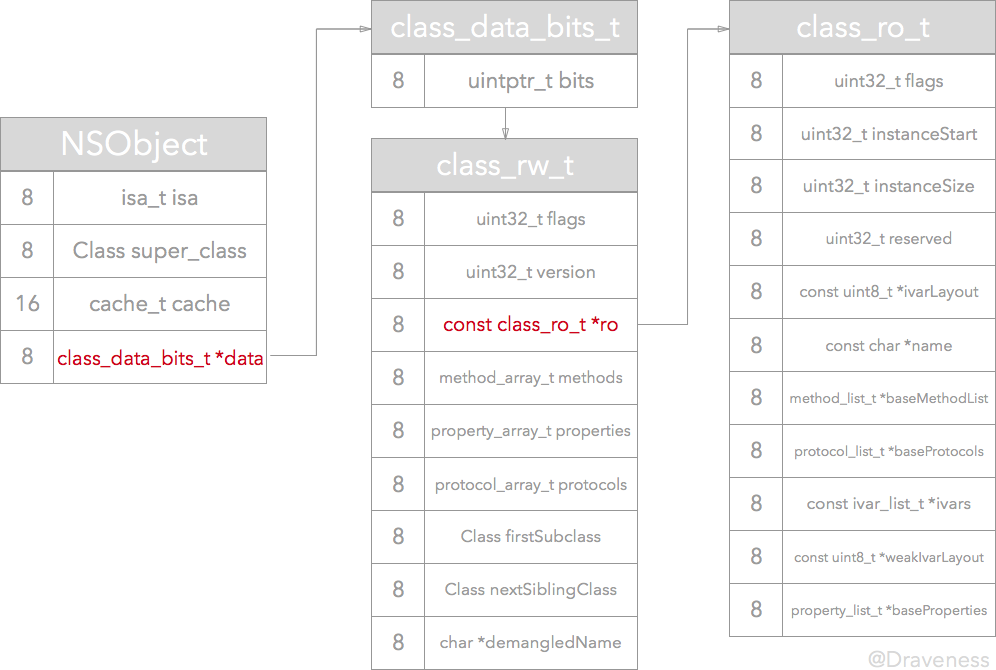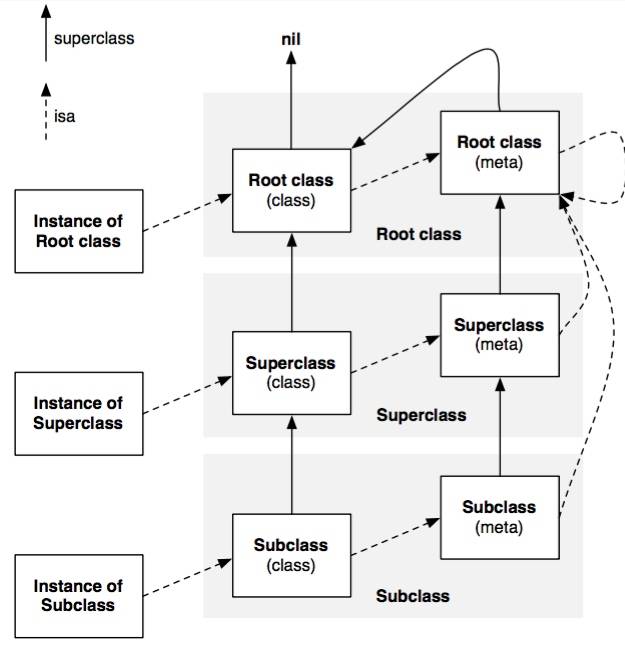一、内存结构
objc_class
OC对象都会转为结构体。OC对象对应的结构体就是objc_class。
1
2
3
4
5
6
struct objc_class {
Class isa;
Class superclass;
cache_t cache; // 方法缓存
class_data_bits_t bits; // 具体的类信息(指针)
};
class_ro_t
class_ro_t存储了当前类在编译期就已经确定的属性、方法以及遵循的协议,里面是没有分类的方法的。那些运行时添加的方法将会存储在运行时生成的class_rw_t中。ro即表示read only,是无法进行修改的。
1
2
3
4
5
6
7
8
9
10
11
struct class_ro_t {
uint32_t flags;
uint32_t instanceStart;
uint32_t instanceSize; //对象占用内存空间
const char * name; //类名
method_list_t *baseMethodList; //方法
protocol_list_t * baseProtocols; //接口
property_list_t *baseProperties; //属性
ivar_list_t * ivars; //成员变量
const uint8_t * weakIvarLayout; // 弱指针
};
class_rw_t
ObjC 类中的属性、方法还有遵循的协议等信息都保存在 class_rw_t中
1
2
3
4
5
6
7
8
9
10
11
12
13
14
15
16
struct class_rw_t {
uint32_t flags;
uint32_t version;
const class_ro_t *ro; //指向ro_t指针
/*
这三个都是二位数组,是可读可写的,包含了类的初始内容、分类的内容。
methods中,存储 method_list_t ----> method_t
二维数组,method_list_t --> method_t
这三个二位数组中的数据有一部分是从class_ro_t中合并过来的。
*/
method_array_t methods; //方法列表
property_array_t properties; //属性列表
protocol_array_t protocols; //协议列表
Class firstSubclass;
Class nextSiblingClass;
};
method_t
与类和对象一样,方法在内存中也是一个结构体。
1
2
3
4
5
struct method_t {
SEL name;
const char *types;
IMP imp;
};

其它参考
二、继承的实现
isa指针是为了查找,方法和类方法。superclass是为了实现继承。方法查找可看成是树上的查找(更准确的说是有向图)。
通过源码可以知道isa的isa_t类型的内部结构
1
2
3
4
5
6
union isa_t {
isa_t() { }
isa_t(uintptr_t value) : bits(value) { }
Class cls;
uintptr_t bits;
};
下面这张图介绍了对象,类与元类之间的关系。

消息发送机制
一、消息发送
1、objc_class的cache中查找(二分查找)
cache是个散列表,散列函数为f(@selector()) = @selector() & _mask,散列处理方式是–i;
2、class_rw_t的方法列表中查找,如果方法没排序遍历查找,如果排序则二分查找
3、从superclass的的cache中查找
4、从superclass的rw_t中查找
(查找结束后,将方法添加到缓存中)
二、动态解析
1、是否已动态解析—->下个阶段
2、resolveInstanceMethod:
resolveClassMethod:
3、标注已动态解析
4、动态解析后,重走消息发送流程
三、消息转发
1、forwardingTargetForSelector. ———>消息转发另个对象
2、methodSignatureForSelector. ———–>完备消息转发
3、doesNotRecognizeSelecter(抛出异常)
addMethod直接在二维方法数组末尾添加一个数组
1
2
3
4
5
6
7
8
9
10
11
12
13
14
15
16
17
18
19
20
21
22
23
24
25
26
27
static IMP addMethod(Class cls, SEL name, IMP imp, const char *types, bool replace)
{
IMP result = nil;
method_t *m;
if ((m = getMethodNoSuper_nolock(cls, name))) {
// already exists
if (!replace) {
result = m->imp(false);
} else {
result = _method_setImplementation(cls, m, imp);
}
} else {
// fixme optimize
method_list_t *newlist;
newlist = (method_list_t *)calloc(method_list_t::byteSize(method_t::bigSize, 1), 1);
newlist->entsizeAndFlags =
(uint32_t)sizeof(struct method_t::big) | fixed_up_method_list;
newlist->count = 1;
auto &first = newlist->begin()->big();
first.name = name;
first.types = strdupIfMutable(types);
first.imp = imp;
addMethods_finish(cls, newlist);
result = nil;
}
return result;
}
###运行时
Runtime(二)isa指针 从 NSObject 的初始化了解 isa isa 和 Class
三、分类
分类的内存结构大体如下
1
2
3
4
5
6
7
8
9
truct category_t {
const char *name; //分类名
classref_t cls; //类
struct method_list_t *instanceMethods;//实例方法列表
struct method_list_t *classMethods; //类方法列表
struct protocol_list_t *protocols; //协议列表
struct property_list_t *instanceProperties; //属性列表
struct property_list_t *_classProperties;
};
1、在运行时加载阶段,会依次加载类相应的分类。
2、分类的方法和实例变量合并到class_rw_t相应的二维数组中。
3、后合并的分类数据,放到原来数据的前面。
1
2
3
4
5
6
7
8
9
10
11
12
13
14
15
16
17
18
19
20
21
22
23
24
25
26
27
28
29
30
31
32
33
34
35
36
37
38
39
40
41
42
43
44
45
46
47
48
49
50
51
52
53
54
55
56
57
58
59
60
61
62
63
64
65
66
67
68
69
70
71
72
73
74
75
static void
attachCategories(Class cls, const locstamped_category_t *cats_list, uint32_t cats_count,
int flags)
{
/*
* Only a few classes have more than 64 categories during launch.
* This uses a little stack, and avoids malloc.
*
* Categories must be added in the proper order, which is back
* to front. To do that with the chunking, we iterate cats_list
* from front to back, build up the local buffers backwards,
* and call attachLists on the chunks. attachLists prepends the
* lists, so the final result is in the expected order.
*/
constexpr uint32_t ATTACH_BUFSIZ = 64;
method_list_t *mlists[ATTACH_BUFSIZ];
property_list_t *proplists[ATTACH_BUFSIZ];
protocol_list_t *protolists[ATTACH_BUFSIZ];
uint32_t mcount = 0;
uint32_t propcount = 0;
uint32_t protocount = 0;
bool fromBundle = NO;
bool isMeta = (flags & ATTACH_METACLASS);
auto rwe = cls->data()->extAllocIfNeeded();
for (uint32_t i = 0; i < cats_count; i++) {
auto& entry = cats_list[i];
method_list_t *mlist = entry.cat->methodsForMeta(isMeta);
if (mlist) {
if (mcount == ATTACH_BUFSIZ) {
prepareMethodLists(cls, mlists, mcount, NO, fromBundle, __func__);
rwe->methods.attachLists(mlists, mcount);
mcount = 0;
}
mlists[ATTACH_BUFSIZ - ++mcount] = mlist;
fromBundle |= entry.hi->isBundle();
}
property_list_t *proplist =
entry.cat->propertiesForMeta(isMeta, entry.hi);
if (proplist) {
if (propcount == ATTACH_BUFSIZ) {
rwe->properties.attachLists(proplists, propcount);
propcount = 0;
}
proplists[ATTACH_BUFSIZ - ++propcount] = proplist;
}
protocol_list_t *protolist = entry.cat->protocolsForMeta(isMeta);
if (protolist) {
if (protocount == ATTACH_BUFSIZ) {
rwe->protocols.attachLists(protolists, protocount);
protocount = 0;
}
protolists[ATTACH_BUFSIZ - ++protocount] = protolist;
}
}
if (mcount > 0) {
prepareMethodLists(cls, mlists + ATTACH_BUFSIZ - mcount, mcount,
NO, fromBundle, __func__);
rwe->methods.attachLists(mlists + ATTACH_BUFSIZ - mcount, mcount);
if (flags & ATTACH_EXISTING) {
flushCaches(cls, __func__, [](Class c){
// constant caches have been dealt with in prepareMethodLists
// if the class still is constant here, it's fine to keep
return !c->cache.isConstantOptimizedCache();
});
}
}
rwe->properties.attachLists(proplists + ATTACH_BUFSIZ - propcount, propcount);
rwe->protocols.attachLists(protolists + ATTACH_BUFSIZ - protocount, protocount);
}
四、关联对象
通过单例存储一个两层的Map。
第一层Map,类(实例)为Key,map为value。
第二层Map,关联对象为Key,关联的对象为value。
五、KVC和KVO
KVO通过动态子类的方式实现观察者模式。
当为类添加KVO时,动态为类对象创建一个子类。
覆盖kvo对象的set方法。
1
2
3
4
5
-(void)_setValueAndNotify{
willChangeValueForKey();
setAge();
didChangeValueForKey();
}
六、load和initialize

七、NSClassFromString实现原理
从汇编代码探究 NSClassFromString 实现分析NSClassFromString实现大体如下.
1
2
3
4
5
6
7
8
9
10
11
12
13
14
15
16
17
18
19
20
21
22
23
24
25
26
Class _Nullable NSClassFromString(NSString *aClassName) {
if (!aClassName) { return Nil; }
NSUInteger classNameLength = [aClassName length];
char buffer[1000];
// @"Big\0Dog" 以及 @"🐶" 都会使得
// classNameLength == strlen(buffer) 不成立
if ([aClassName getCString:buffer maxLength:1000 encoding:NSUTF8StringEncoding]
&& classNameLength == strlen(buffer)) {
return objc_lookUpClass(buffer);
} else if (classNameLength == 0) {
// 检查是否空字符串 @"",这个分支要处理的情况不太理解
return objc_lookUpClass([aClassName UTF8String]);
}
for (int i = 0; i < classNameLength; i++) {
// 如果 aClassName 中含有 \0 字符,向外返回 Nil
// 比如 @"Big\0Dog" 的情况
if ([aClassName characterAtIndex:i] == 0) {
return Nil;
}
}
return objc_lookUpClass([aClassName UTF8String]);
}
也就是说NSClassFromString最终会调用objc_lookUpClass方法
1
2
3
4
5
6
7
8
9
10
11
12
13
14
15
16
17
18
19
20
21
22
23
24
25
26
27
28
29
30
31
32
33
34
35
36
37
38
39
40
41
42
43
44
45
46
47
48
49
50
51
52
53
54
55
/***********************************************************************
* look_up_class
* Map a class name to a class using various methods.
* This is the common implementation of objc_lookUpClass and objc_getClass,
* and is also used internally to get additional search options.
* Sequence:
* 1. class_hash
* 2. unconnected_class_hash (optional)
* 3. classLoader callback
* 4. classHandler callback (optional)
**********************************************************************/
Class look_up_class(const char *aClassName, bool includeUnconnected,
bool includeClassHandler)
{
bool includeClassLoader = YES; // class loader cannot be skipped
Class result = nil;
struct objc_class query;
query.name = aClassName;
retry:
if (!result && class_hash) {
// Check ordinary classes
mutex_locker_t lock(classLock);
result = (Class)NXHashGet(class_hash, &query);
}
if (!result && includeUnconnected && unconnected_class_hash) {
// Check not-yet-connected classes
mutex_locker_t lock(classLock);
result = (Class)NXHashGet(unconnected_class_hash, &query);
}
if (!result && includeClassLoader && _objc_classLoader) {
// Try class loader callback
if ((*_objc_classLoader)(aClassName)) {
// Re-try lookup without class loader
includeClassLoader = NO;
goto retry;
}
}
if (!result && includeClassHandler && objc_classHandler) {
// Try class handler callback
if ((*objc_classHandler)(aClassName)) {
// Re-try lookup without class handler or class loader
includeClassLoader = NO;
includeClassHandler = NO;
goto retry;
}
}
return result;
}
objc_lookUpClass通过一个通过NXHashGet方法,查找一个方法名的hash表.
1
2
3
4
5
6
7
8
9
10
11
12
13
14
15
16
17
18
19
20
21
22
23
24
25
26
27
28
29
30
31
32
33
34
35
/***********************************************************************
* getClassExceptSomeSwift
* Looks up a class by name. The class MIGHT NOT be realized.
* Demangled Swift names are recognized.
* Classes known to the Swift runtime but not yet used are NOT recognized.
* (such as subclasses of un-instantiated generics)
* Use look_up_class() to find them as well.
* Locking: runtimeLock must be read- or write-locked by the caller.
**********************************************************************/
// This is a misnomer: gdb_objc_realized_classes is actually a list of
// named classes not in the dyld shared cache, whether realized or not.
// This list excludes lazily named classes, which have to be looked up
// using a getClass hook.
NXMapTable *gdb_objc_realized_classes; // exported for debuggers in objc-gdb.h
static Class getClass_impl(const char *name)
{
runtimeLock.assertLocked();
// allocated in _read_images
ASSERT(gdb_objc_realized_classes);
// Try runtime-allocated table
Class result = (Class)NXMapGet(gdb_objc_realized_classes, name);
if (result) return result;
// Try table from dyld shared cache.
// Note we do this last to handle the case where we dlopen'ed a shared cache
// dylib with duplicates of classes already present in the main executable.
// In that case, we put the class from the main executable in
// gdb_objc_realized_classes and want to check that before considering any
// newly loaded shared cache binaries.
return getPreoptimizedClass(name);
}